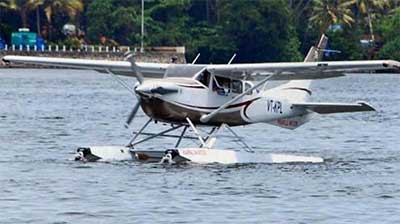Sagarmala Seaplane Services
IN NEWS
Ministry of Ports, Shipping and Waterways launched the Sagarmala Seaplane services on 4th January, 2021 with prospective airline operators.
ABOUT
- Ministry has planned to start off the operations of seaplane services on selected routes under Special Purpose Vehicle framework.
- Sagarmala Development Company Limited (SDCL), working under the Ministry of Ports, Shipping and Waterways is responsible for the execution and implementation of this project.
- Kevadia and Sabarmati riverfront in Ahmadabad is the operational seaplane service that was inaugurated by PM Shri Narendra Modi on 31st October, 2020.
- SDCL is interested to associate with scheduled and non-scheduled airline operators to promote seaplane services in coastal areas and those areas that are near water bodies.
- Sea Plane service will provide connectivity and easier accessibility to remote areas.
- Sea Plane will take off and land on nearby water bodies that in a way would be very economical in comparison to other planes that need airport and runway for above purposes.
- Sea plane service will provide connectivity to remote religious and tourist places thus giving a boost to tourism, employment and other business activities.
- It will also attract tourist not only from domestic front but also from International front.
- This project aligns with the vision of PM Narendra Modi to enhance connectivity across the nation and make India a hub of tourist destination.
Hub and Spoke Model
The sea plane service is based on Hub and Spoke model.
This model refers to an arrangement where a centralized ‘hub’ exists. Everything either emerges in the hub or is sent to the hub for distribution to the end user. Goods travel from the hub to outward smaller locations owned by the company, called ‘spokes’, for further processing and distribution.
The hub and spokes model has been actually revolutionized by the airline industry only. Airlines operate out of a centralized hub and make use of the regional airports from which they offer flights as the spokes. These small regional airports (the "spokes") perform the work of transporting the passengers to one of the larger centralized (hub) airports. From here, a connecting flight takes them to another regional airport (spoke). This route and procedure is far more efficient and effective than having numerous direct routes from one regional airport to another regional airport.
However this model has its disadvantages too which is felt primarily by the passengers, as they might experience delayed flights and also increased transit time by getting on two different flights rather than one direct flight In addition the crowding and the congestion at the centralized airport i.e the hub may cause dissatisfaction among the travelling passengers.
Although most of the larger airlines are of the view that the advantages of the hub and spoke model outweigh its demerits still many of the smaller airlines are focusing their attention on the service gap of offering regional direct flights.







